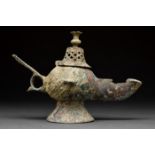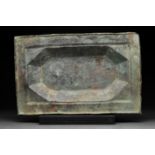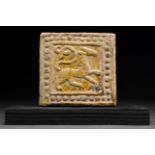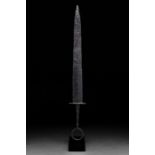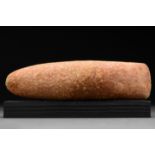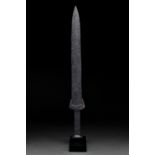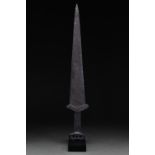Verfeinern Sie Ihre Suche
Schätzpreis
Kategorie
- Arms, Armour & Militaria (108)
- Greek, Roman, Egyptian & Other Antiquities (68)
- Jewellery (41)
- Sculpture (35)
- Chinese Works of Art (32)
- Glassware (11)
- Ceramics (5)
- Coins (5)
- Collectables (4)
- Porcelain (4)
- Islamic Works of Art (3)
- Stamps (3)
- Books & Periodicals (2)
- Metalware (2)
- Scientific Instruments (2)
- Taxidermy & Natural History (2)
- Kitchenalia (1)
- Textiles (1)
- Vintage Fashion (1)
- Liste
- Galerie
Ein Abonnement der Preisliste ist notwendig um Ergebnisse, von Auktionen die vor einem längeren Zeitraum als 10 Tagen stattgefunden haben, ansehen zu können. Klicken Sie hier für mehr Informationen
SELJUK BRONZE OIL LAMP
Ca. 1100–1300 AD. Seljuk. A bronze oil lamp comprising a conical base and a piriform body with a round nozzle. The hinged openwork lid is surround...
SELJUK BRONZE PLATE
Ca. 1100–1300 AD. Seljuk. A bronze rectangular plate with an irregular octagonal bowl and a finely incised frame. The surface displays a beautiful...
WESTERN ASIATIC BRONZE BOWL
Ca. 800–500 BC. Western Asiatic. An outstanding Western Asiatic / Achaemenid bronze wine bowl with a slightly flaring rim; a beautiful polish enha...
WESTERN ASIATIC BRONZE BOWL
Ca. 800–500 BC. Western Asiatic. An outstanding Western Asiatic / Achaemenid bronze wine bowl with a slightly flaring rim; a beautiful, dark polis...
WESTERN ASIATIC BRONZE BOWL
Ca. 800–500 BC. Western Asiatic. An outstanding, deep Western Asiatic / Achaemenid bronze wine bowl with a high rim; a beautiful patina enhances t...
Ca. 3100–2500 BC. Bactrian. A fine Bactrian alabaster vessel, featuring a rounded flared base and a tall conical body. It has a beautiful cream co...
PERSIAN GLAZED TILE
Ca. 1300–1500 AD. Persian, probably Kashan. A beautiful tile of rectangular form, decorated in yellowish lustre with a beast in the centre and geo...
Ca. 3100–2500 BC. Bactrian. A fine Bactrian alabaster vessel, featuring a flat foot, a bulbous body and a rounded rim. It has a beautiful cream co...
Ca. 3100–2500 BC. Bactrian. A stunning alabaster chalice with a tall stem and a conical base topped with a bowl with slightly flaring walls. It ha...
CHINESE TANG TERRACOTTA CAMEL
Ca. 618–907 AD. Tang Dynasty. A superbly modelled terracotta camel standing four square on a low rectangular base. The full-bellied beast has long...
Ca. 1100–1300 AD. Seljuk. A beautiful bronze mortar of octagonal form with flattened rim and flared foot, two sides with lion's head suspension lo...
Ca. 500–300 BC. Greek. A beautiful Chalcidian bronze helmet. The stylised and ornately decorated bowl is forged in one piece, the crown shows the ...
Ca. 200–400 AD. Late Roman. A beautiful legionary sword of the 'spatha' type. This broad parallel-sided spatha has a convergent tip and a slender ...
Ca. 200–400 AD. Roman. An iron spatha with a long tapering, bevelled blade, and a reconstructed bone hilt with a circular pommel and a cylindrical...
Ca. 600–400 BC. Scythian / Hellenistic. A well preserved short iron sword of the akinakes type (Greek ????????') with a pointed bevelled blade, fl...
ANCIENT BRONZE SWORD
Ca. 1200–700 BC. Western Asiatic/Aegean. This beautiful cast bronze sword has a tapering, bevelled blade with a raised midrib, triangular guard wi...
ANCIENT BRONZE SWORD
Ca. 1200–700 BC. Western Asiatic/Aegean. A bronze sword with an elongated leaf-shaped blade, raised midrib, and short tang for insertion into a hi...
ANCIENT BRONZE SWORD
Ca. 1200–700 BC. Western Asiatic/Aegean. A large and well-formed bronze blade with a central raised ridge that bifurcates at the base of the blade...
Ca. 1200–700 BC. Western Asiatic. A bronze dagger with a long, leaf-shaped bevelled blade, horizontal guard, concave handle that would have been i...
Ca. 1200–700 BC. Western Asiatic. A bronze dagger with a long, bevelled blade, folded-in guard, concave handle that would have been inset with sto...
Ca. 900–1100 AD. Viking Age. An iron axe head comprising a curved blade, elongated cheek, lozenge-shaped poll and round socket. Fair condition; mo...
Ca. 900–1100 AD. Viking Age. This iron battle axe features a square socket with linear decoration in the shape of triangles, a triangular-section ...
Ca. 900–1100 AD. Viking Age. A heavy iron battle axe with a curved blade, a tapering cheek, a heavy, reinforced poll and socket. Good condition; m...
Ca. 900–1100 AD. Viking Age. A rare cross axe head with a triangular rounded blade, a round socket with rectangular flanges above and below, and a...
MEDIEVAL IRON BATTLE HAMMER
Ca. 1400 AD. Medieval Europe. An iron battle hammer with a long blade with a rectangular section, a curved cutting edge, and a reinforced poll. We...
Ca. 900–1100 AD. Viking Age. An iron axe head with a curved blade, triangular cheek, elliptical shaft-hole, and a hammer poll. The profile is squa...
Ca. 1200–700 BC. Western Asiatic. A finely modelled Western-Asiatic cast bronze double axe head, composed of a long, tubular socket with four ribb...
Ca. 1200–700 BC. Western Asiatic. A finely modelled Western-Asiatic cast bronze axe. Bronze weaponry production flourished from the 2nd millennium...
Ca. 1200–700 BC. Western Asiatic. A finely modelled Western-Asiatic cast bronze double axe head, composed of a long, tubular socket with a ribbed ...
Ca. 1200–700 BC. Western Asiatic. A finely modelled Western-Asiatic cast bronze double axe head, composed of a short, tubular socket with a ribbed...
Ca. 1200–700 BC. Western Asiatic. A gorgeous cast flat axe head with a spiked butt. The head is elongated and rectangular, broadening into a flat,...
BRONZE AGE SOCKETED AXE HEAD
Ca. 800–600 BC. European. A hefty bronze axe head with a flared blade, blunt sides, a thick neck, and a rounded collar with a hoop.The head is soc...
Ca. 1200–700 BC. Western Asiatic/Aegean. A bronze spearhead with a leaf-shaped blade, barbs, raised midrib, sharpened edges that taper gradually t...
Ca. 1200–700 BC. Western Asiatic/Aegean. A bronze spearhead with an elongated leaf-shaped blade and barbs, wide raised midrib, and a short socket ...
Ca. 1200–700 BC. Western Asiatic/Aegean. A bronze spear with an elongated leaf-shaped blade with a raised midrib, sharpened edges that taper gradu...
ROMAN IRON SPEARHEAD
Ca. 100–300 AD. Roman. An iron spearhead with an elongated leaf-shaped blade, raised midrib, sharp tapering edges, and a long flared socket. Good ...
Ca. 1000–1200 AD. Viking Age. An iron spearhead with a leaf-shaped blade, sharp edges flaring slightly before tapering to a pointed tip, and a lon...
MEDIEVAL IRON SPEARHEAD
Ca. 900–1100 AD. Viking age. An iron spearhead with a leaf-shaped blade, raised midrib, sharp edges flaring slightly before tapering to a pointed ...
ROMAN IRON SPEARHEAD
Ca. 300–500 AD. Roman. An iron spearhead with an elongated leaf-shaped blade, raised midrib, sharp tapering edges, and a long flared socket. Good ...
BYZANTINE POTTERY GREEK FIRE GRENADE
Ca. 900–1100 AD. Byzantine. A cream-coloured “Greek fire” grenade comprising a domed lid and a globular body decorated with linear, circular, and ...
BYZANTINE POTTERY GREEK FIRE GRENADE
Ca. 900–1100 AD. Byzantine. A cream-coloured “Greek fire” grenade in the shape of a pomegranate. Good condition; custom-made stand included. It is...
Ca. 900–1100 AD. Byzantine. A cream-coloured “Greek fire” grenade comprising a domed lid, a pointed base, and an elongated globular body decorated...
Ca. 5000 BC. Neolithic period, Northern Europe. A large polished red-coloured stone axe with rounded edges, broad curved blade, and pointed poll. ...
NEOLITHIC STONE AXEHEAD
Ca. 4000 BC. Neolithic, Northern Europe. A speckled dark grey stone perforated axehead, drilled to the centre and with flat butt to both ends. Pro...
Ca. 2000–1700 BC. Neolithic period, NORTHERN EUROOE / SCANDINAVIA. A beautiful nordic flint dagger, grey in colour, with an elongated leaf-shaped ...
ANCIENT BRONZE URARTU BELT
Ca. 1000–650 AD. Western Asiatic, Urartu. A rare, intact bronze belt made of a wide lateral bronze band embellished with geometric, floral decorat...
Ca. 900–1100 AD. Viking Age. An iron helmet comprising four triangular curved iron plates with bands outside supporting the structure of the helme...
MEDIEVAL CRUSADERS IRON SWORD
Ca. 1100–1400 AD. Crusader Period. A beautiful iron sword with a long, bevelled blade, short guard, and long, two-handed grip, terminating in a po...
ROMAN IRON SPATHA SWORD
Ca. 200–400 AD. Roman. An iron spatha with a long tapering, bevelled blade, and a reconstructed bone hilt with a flat circular pommel and guard, a...
Ca. 100–300 AD. Roman. An iron pilum spearhead with a barbed, triangular blade, and a long twisted neck, and a robust flaring socket decorated wit...
Ca. 600–400 BC. Scythian / Hellenistic. A well preserved short iron sword of the akinakes type (Greek '????????') with a pointed bevelled blade, b...
Ca. 600–400 BC. Scythian / Hellenistic. A well preserved short iron sword of the akinakes type (Greek '????????') with a pointed bevelled blade, b...
ANCIENT BRONZE SWORD
Ca. 1200–700 BC. Western Asiatic/Aegean. A stunning bronze sword with an elongated leaf-shaped blade, raised midrib, rounded guard and tubular gri...
Ca. 1100–900 BC. Aegean. A bronze Troy-type sword blade, leaf-shaped in plan with curved barbs; the raised midrib extends to the short tang with f...
ANCIENT BRONZE SWORD
Ca. 1200–700 BC. Western Asiatic/Aegean. A bronze sword with an elongated leaf-shaped blade, raised midrib, and short tang for insertion into a hi...
Ca. 1200–700 BC. Western Asiatic/Aegean. A bronze spearhead with an elongated leaf-shaped blade, a raised midrib, bevelled edges that taper gradua...
Ca. 1200–700 BC. Western Asiatic/Aegean. A bronze sword with a leaf-shaped blade, raised mid-rib, penannular guard, concave grip, and a crescent m...
ANCIENT BRONZE AND IRON DAGGER
Ca. 1200–700 BC. Western Asiatic. A fine dagger with a leaf-shaped flat-section iron blade and a bronze hilt with ribbed socket and lozengiform gr...
VIKING IRON BEARDED AXE ON STAND
Ca. 900–1100 AD. Viking Age. An iron axe head with a very long, flaring cheek, curved blade, and reinforced poll. Good condition; custom-made stan...
Ca. 900–1100 AD. Viking Age. An iron battle axe with a wide, fan-shaped blade, tapering cheek, heavy poll and lozenge-shaped socket. Good conditio...

